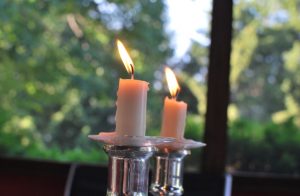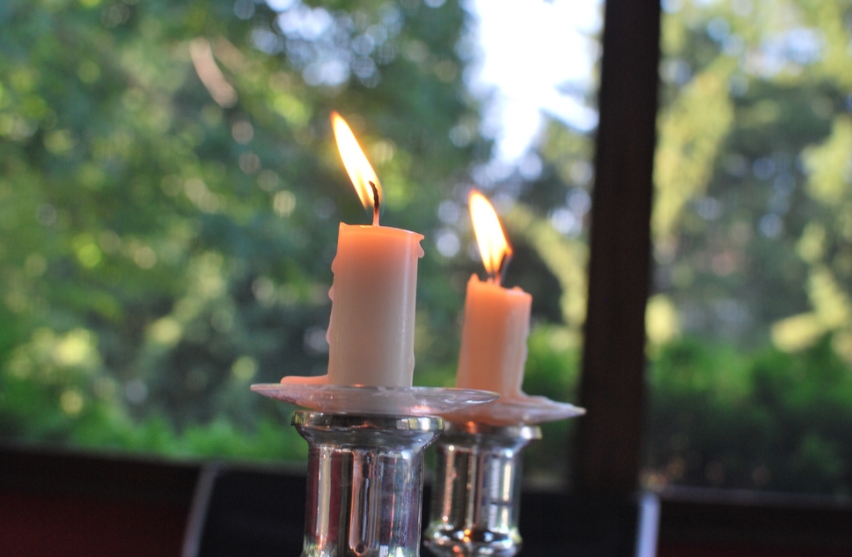
BS”D
Volume 32, No. 19
2 Adar 5778
February 17, 2018
Sponsored by
Mrs. Rochelle Dimont and family
on the yahrzeits of
father-in-law and grandfather
Rabbi Shmuel Elchanan Dimont a”h (2 Adar)
and mother and grandmother
Mrs. Chaya Tarshish a”h (7 Adar)
The Katz family, on the yahrzeits of
Yitzchak Zvi ben Chaim Hakohen a”h,
Avraham Abba ben Avigdor Moshe Hakohen a”h, and
Etia bat Avigdor Moshe Hakohen a”h
In this week’s Parashah, we read of the Mitzvah to build the Mishkan / Tabernacle and, later, the Bet Hamikdash. R’ Shalom Noach Berezovsky z”l (1911-2000; Slonimer Rebbe in Yerushalayim) writes: The Bet Hamikdash is the “soul” of all of Creation. [Like the spiritual soul in the midst of the physical body,] Hashem sent a “light” from the upper worlds into this world of lowly physical desires in order to elevate the Jewish People. The service in the Bet Hamikdash and the Keilim / implements and furnishings there brought purity to Klal Yisrael, giving them the strength to persevere in the “darkness” of this world. In this way, we may explain the verse, “They shall make a Sanctuary for Me — so that I may dwell among them”– within each and every one of them. The Bet Hamikdash purified every Jew so that the Shechinah could dwell within him.
The Slonimer Rebbe continues: The Bet Hamikdash, a geographical place (“Makom”), has a parallel in the dimension of time (“Shanah”). That is Shabbat, which brings holiness to the Jewish soul no matter how lowly its condition. In the words of our Sages, “If someone keeps Shabbat with all its laws, then even if he worships idols, he will be forgiven.” Shabbat is the opportunity for every Jew to “come home,” even from the depths of lowliness.
The Bet Hamikdash and Shabbat have a parallel in the spiritual world (“Nefesh”), and that is the Torah. Through the Torah, also, a person can attach himself to Hashem. (Nesivos Shalom: Shmot p.209)
********
“Like everything that I show you, the form of the Mishkan / Tabernacle and the form of all its vessels; and so you shall do.” (25:9)
R’ Yaakov Yokel Ettlinger z”l (1798-1871; Germany; author of the Talmud commentary, Aruch La’ner) notes that the phrase “and so you shall do” seems to be superfluous. He explains its purpose as follows:
Commentaries note that some of the furnishings of the Mishkan had dimensions in whole units, some in half-units, and some in a combination of whole units and half-units. Other furnishings had no specified dimensions at all. For example:
The Aron / Ark was two-and-a-half Amot long, one-and-a-half Amot wide, and one-and-a-half Amot tall. The Aron housed the Torah, R’ Ettlinger explains, and the horizontal dimensions are not whole numbers to remind the Torah scholar that his studies are never completed. The height is not a whole number to remind the Torah scholar that, although he must act dignified in front of other people in order to preserve the Torah’s honor, inside, he must remain humble.
The Shulchan / Table was two Amot long, one Amah wide, and one-and-a-half Amot tall. The Shulchan symbolizes wealth, R’ Ettlinger writes, and the whole numbers represent being happy with one’s lot, which is what truly makes a person wealthy. One of the dimensions includes a half to remind a person to exercise restraint eating, drinking, and other material pursuits.
The Menorah had no specified dimensions. The Menorah alludes to the soul, as we read (Mishlei 20:27), “Man’s soul is a lamp of Hashem.” Spiritual things take up so space; hence, the Menorah had no fixed dimensions.
All of the dimensions of the altars were whole numbers, reminding a sinner who is bringing a sacrifice to achieve atonement that he should repent whole-heartedly.
In light of the foregoing, concludes R’ Ettlinger, the meaning of the phrase, “And so you shall do,” is clear. Specifically, the Torah is teaching us to imitate the various furnishings in our own lives. (Minchat Ani)
Another explanation:
Rashi comments: “And so shall you do”– for future generations.
R’ Eliezer Zusia Portugal z”l (1898-1982; the Skulener Rebbe) asks: How can building a Temple be a mitzvah for future generations when, at least according to some opinions, the Third Temple will descend from Heaven as a building of fire?
He answers: The Temple that will descend is being constructed all the time from our mitzvot. Every good deed adds a course of “bricks” to that Temple. This verse is commanding us to do those good deeds. (Noam Eliezer)
********
“You shall place [literally ‘give’] in the Aron the Luchot of Testimony that I shall give you.” (25:16)
R’ Moshe Hager z”l (1916-2012; Vizhnitzer Rebbe) writes: Some people find it difficult to give charity because they think that their wealth is the product of their hard work. They fail to realize that they are mortal beings just like the person asking for tzedakah; that but for G-d’s decree, their positions in society could just as well have been the reverse.
Our verse may be interpreted as a response to those whose hands are closed. “You shall give.” To whom? To those who hold the Luchot, i.e., to Torah scholars and the institutions that support them. If you do, it will show that you understand that “I shall give you,” i.e., that your wealth is not your own but rather a gift from Me. (Kuntreis Avodat Hashem B’yemei Ha’Shovavim p.33)
********
“You shall make the Mizbei’ach / Altar of acacia wood, five Amot long and five Amot wide — the Altar shall be square — and three Amot high.” (27:1)
The Ba’alei Ha’Tosafot z”l (12th and 13th century; France and Germany) comment: “חבזמ / Altar” is an acronym of “Mechilah / Forgiveness,” “Zechut/ Merit,” “Berachah / Blessing,” and “Chaim / Life.”
They continue: “Five Amot [long and five Amot wide]”–paralleling the Aseret Ha’dibrot / Ten Commandments–five on one tablet and five on the second tablet.
Finally, “Three Amot [high]”–paralleling the three redeemers: Moshe, Aharon, and Miriam. (Da’at Zekeinim Mi’Ba’alei Ha’Tosafot)
R’ Chaim Zaichyk z”l (1906-1989; Rosh Yeshiva of Yeshivat Bet Yosef-Novardok in Buchach, Poland; later in Israel) asks: Where do we find Miriam playing any role in the redemption of the Jewish People?
He explains: First, Miriam was the catalyst for Moshe’s birth. Our Sages teach that, when Pharaoh decreed that all newborn boys be killed, Miriam’s father, Amram, separated from his wife Yocheved. Miriam rebuked him, saying, “Pharaoh only decreed against the males. Your action will result in no girls being born either.” Amram then reunited with Yocheved and Moshe was born.
Also, when Moshe was placed in a basket in the river, it was Miriam who kept watch over him, and it was she who went to bring Yocheved to nurse Moshe on behalf of Pharaoh’s daughter. Because of Miriam’s devotion to, and self-sacrifice for, Moshe, she is considered a partner in his redemption of Bnei Yisrael.
R’ Zaichyk concludes: One who participates in Bnei Yisrael’s suffering will be a participant in their joy. One who is an accessory to the performance of a Mitzvah is given credit as if he did the Mitzvah. These statements describe Miriam’s role vis-á-vis her brothers, the redeemers. (Ma’ayanei Ha’Chaim)
********
Memories of Yerushalayim
R’ Ben-Zion Yadler z”l (1871-1962; “Maggid / preacher of Yerushalayim”), describes in his memoir, B’tuv Yerushalayim, some outstanding members of Yerushalayim’s working class at the turn of the 20th century.
R’ Shmuel Schneider, who sewed garments in the Yerushalmi style, conducted his business honestly and set aside much time for Torah and prayer. One who didn’t know him would think he was one of the great men of Yerushalayim and one of its dignitaries, for his wisdom shone on his face.
When R’ Yitzchak (Itzele) Blazer zt”l [1837-1907; one of the most prominent students of Rabbi Yisrael Salanter z”l] settled in Yerushalayim, he sent for R’ Shmuel to come and take his measurements so that R’ Shmuel could sew Yerushalmi garments for him. When R’ Shmuel arrived at his home, the sage thought that one of the rabbis of Yerushalayim had come to welcome him to Eretz Yisrael. Immediately, R’ Itzele stood up and invited his guest to sit, and they discussed Torah and mussar (character improvement) subjects together for a long time. Finally, R’ Shmuel got up and said, “Forgive me, rabbi. Please allow me to take your measurements as I was summoned to do.” R’ Itzele was astounded and said, “Indeed! This is the Yerushalmi tailor, and I had no idea. Fortunate are you, Yerushalayim, that a tailor such as this lives in your midst.” . . .
R’ Naftali Meller (the painter) and R’ Herschel Blecher (the blacksmith) both served as representatives of the congregation [i.e., chazzanim] in the large Menachem Zion shul in the churvah / ruin of Rabbi Yehuda He’chassid on yom tov and the High Holidays. They were exceptional Torah scholars and possessed extraordinary awe of G-d. They were among the most important of the mussar scholars in Yerushalayim.
All of this and more were the fruits of the sacrifices that the earlier generations, who were like angels, made to attain awe of G-d. Even the youth who were apprenticed to tradesmen acted like mentschen and overflowed with Torah and awe of G-d. Alas, alas, for that which is lost but not forgotten!


